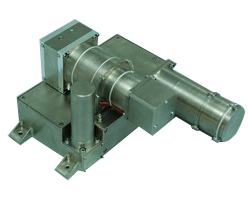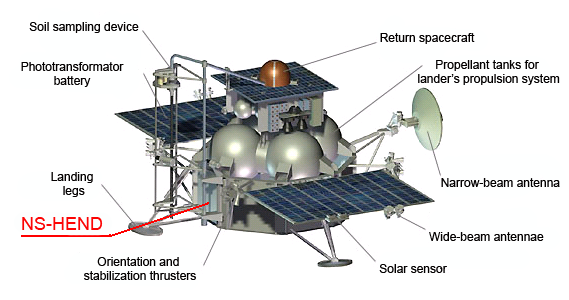NS-HEND Neutron Spectrometer for Phobos-Grunt project
-------------------------------------------------------------------------------------------------------------------------------------------------
-------------------------------------------------------------------------------------------------------------------------------------------------

The main task of the experiment is to study elemental composition of the Phobos's surface using neutron and gamma-ray spectroscopy. The data characterizing the distribution of main rockforming elements and possible water deposits on Phobos might shed light on the conditions of its origin and processes Phobos has undergone during its evolution. Then, the instrument can be also used to search for the most interesting site for Phobos-Grunt landing and soil samples collection to be returned to the Earth.
NS-HEND will be used to measure high energy neutron and gamma-ray fluxes during interplanetary cruise, in orbit around Mars, near Phobos, and during landing on the Phobos's surface.
The basic principle used by NS-HEND is registration of secondary neutrons and gamma-ray born in the shallow layer of Phobos surface (1–2 m deep) exposed to charged particles of cosmic rays.
High energy neutrons born in the soil are moderated and absorbed by main rockforming nuclei in the inelastic scattering (effective mostly for fast neutrons) and capture (for slow and thermal neutrons) reactions, thus generating a 'forest' of gamma-ray lines with characteristic energies corresponding to certain chemical elements. Gamma-ray linear spectrum is a unique 'fingerprint' holding information on the elemental composition of this Martian satellite's surface.
Additionally, neutron flux emanating from the surface also depends on its composition, namely, on hydrogen or hydrogen-bearing compounds in the first place. Having collided with a hydrogen nucleus, a neutron immediately loses half of its energy which leads to quick thermalization and, thus, to a strong increase on thermal neutron flux and decrease of epithermal neutron flux.
Thus, presence of hydrogen or water , which is the dominant hydrogen-bearing compound, effects both neutron albedo and gamma ray spectrum, with neutron-absorption lines begining to dominate in the latter case.
NS-HEND has a monobloc design comprising control electronics and thermal, epithermal, and fast neutron detectors. Furthermore, NS-HEND also includes gamma-ray spectrometer to measure nuclear lines of main rockforming elements.
NS-HEND consists of main elements as follows:
- three detectors: SD, SD/Cd, and MD — built using proportional neutron counters, differentiated by their external shields, namely, by polyethylene moderator and cadmium shield for MD detector and SD/Cd detector respectively;
- NS neutron scintillation unit, consisting of two detectors: IN and OUT. The cylinder-shaped IN detector (stilbene) is located inside the glass-shaped plastic OUT detector with thick walls. Each of the detectors consists of a scintillator and a photomultiplier;
- GRS gamma-ray scintillation unit, comprising a cylinder-shaped detector on the basis of a LaBr3 crystal and a photomultiplier;
- Electronics components:
- Main electronics board (Actel FPGA);
- Secondary power source node;
- LaBr3 detector unit (GreenStar board);
- FRE node: SD, SD/Cd and MD detectors' electronics;
- High-voltage power supply (HV);
- DR5611 photomultiplier based OUT detector (DR5611);
- DR5611 photomultiplier based IN detector (DR1840);
- photomultiplier electronics DR5611;
- photomultiplier electronics DR1840;
- Separation circuit board from DR5611/IN photomultiplier
The instrument allows to measure the following physical parameters (see Table 1) during Mars cruise phase, in orbit around Mars, near Phobos, and on the surface of Phobos.
Table 1
| Physical quantity | Measured parameters | Measuring unit |
| Thermal and epithermal neutron flux | Neutron count rate for the energy range of 0.01–1.00 keV | SD detector |
| Epithermal neutron flux | Neutron count rate for the energy range of 0.4 eV – 1.0 keV | SD/Cd detector |
| Fast neutron flux | Neutron count rate for the energy range of 1.0 keV – 1.0 MeV | MD detector |
| High energy neutron flux | Neutron count rate for the energy range of 1.0–10.0 MeV | IN detector |
| Gamma-ray background spectrum | Gamma-ray count rate in the energy range 300 keV – 10 MeV | IN detector |
| X-ray background flux spectrum | X-ray count rate in the energy range of 30 keV – 1.0 MeV | OUT detector |
| Gamma-ray spectrum | Gamma-ray spectra in the energy range of 100 keV – 8 MeV with the energy resolution up to 4% at Cs137 line | GRS detector |
NS-HEND general view is shown in Fig. 1.

Fig. 1. NS-HEND. General view
Thermal and epithermal neutron detectors are built using 3He-filled proportional counters with cadmium and polyethylene used as outer shells to register epithermal neutrons. Neutrons are detected in the helium-filled gas counters thanks to neutron capture reaction:
3He + n= 3H + p + 765keV
Similar detectors were used in the Russian HEND instrument (developed by IKI RAS), which is still successfully working onboard the Mars Odyssey interplanetary spacecraft.
High energy neutron detector (operating in the energy range of 300 keV – 15 MeV) holds a scintillation detector built on the basis of a stilbene crystal surrounded by an outer plastic scintillator to shield the former from cosmic rays, i.e. high-energy charged particles. Fast neutrons are detected by recoil protons born in the crystal matter. Similar detector is also used in the Russian HEND instrument.
Gamma-ray spectrometer includes multi-channel measuring electronics and gamma-ray detector exploiting a new generation LaBr3 scintillation crystal, which surpasses its classic predecessors (such as CsI) in the energy resolution and the registration efficiency.
NS-HEND would be mounted on the science deck of the lander module within Phobos-Grunt spacecraft. It would be connected by a special controlled thermal interface with the spacecraft, and isolated by a multilayer insulation (MLI) from the outer space. Lander systems would maintain instrument's working temperature within −40...+40 degrees Celsius temperature range. Electrical, data, and command interfaces are developed in compliance with the project's requirements. Preliminary location of the NS-HEND instrument aboard Phobos-Grunt is shown in Fig. 2.

Fig. 2. NS-HEND mount aboard the Phobos-Grunt spacecraft
| Mass : | 3.8 kg |
| Power consumption : | 9 W |
| Dimensions : | 230 x 290 x 240 mm |
| Energy range : | from thermal energies to 15 MeV |
| Energy resolution (gamma-ray) : | 3% at 660 keV |
| Depth resolution : | 1-2 m |
| Telemetry : | 30 Mb per day |
Funding organization — Federal Space Agency of the Russian Federation
Primary contractor — Space Research Institute of the Russian Academy of Sciences (IKI RAS).
Principal Investigator — Dr. Igor Mitrofanov.
Works on NS-HEND project are carried out on the basis of the State contract №025-5443/02 of April 12, 2006 between the Federal Space Agency and the Space Research Institute and are included in the Federal Space Program of the Russian Federation for 2006–2015. R&D works on the development of the NS-HEND instrument were included into the Phobos-Grunt project in compliance with the decision made by the Space Council of the Russian Academy of Sciences.
The AIS was launched on November 9, 2011, but as a result of an emergency situation, when the calculated response of the flight propulsion unit of the SC did not occur, the interplanetary station could not leave the Earth’s orbit, staying on the low near-earth orbit. On January 15, 2012, AIS burned down in dense layers of the earth's atmosphere.
| Lavochkin Research and Production Association (Khimki, Moscow distr.) |
Instrument testing within complex Phobos-Grunt testbed. Instrument integration. Operation, telemetry, and scientific data acquisition. Telemetry control and data processing. |
| Joint Institute for Nuclear Research (Dubna, Moscow district) |
Numerical modeling of NS-HEND counting parameters; participation in the development of NS-HEND physical scheme; preparation for and calibrations of the instrument using natural and artificial neutron sources. |
| A.A. Blagonravov Institute for Engineering Science of the Russian Academy of Sciences (IMASH, Moscow) |
Development of the mathematical model of the instrument's mechanical structure; participation in the development of testing facilities for the NS-HEND instrument in compliance with project requirements; development of mechanical test program; support of the instrument testing. |
| A.F. Ioffe Physical Technical Institute (FTI, St.-Petersburg) |
Analysis of conditions of the Phobos's neutron albedo formation and its spectrum dependence on temperature for data processing. |
| Joint-Stock-Company «Specialized scientific research institute for instrumentation engineering» (SNIIP, Moscow) |
Electronic scheme design development for the fast neutron registration. |
| N.M. Fedorovsky All-Russian Scientific Research Institute for Mineral Raw Materials of Ministry of Natural Resources and Environment of the Russian Federation (Moscow) |
Development of the scintillation unit for the fast neutrons registration. |



